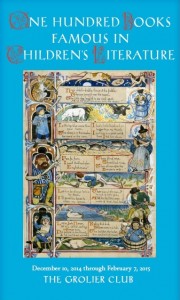Everyone likes a best-of list, right? So when I heard about an exhibit of “One Hundred Books Famous in Children’s Literature,”  I had to go. Yesterday, despite a little blizzard, we made our way down to the venerable Grolier Club in Manhattan to view this small, wonderful, free exhibit.
I had to go. Yesterday, despite a little blizzard, we made our way down to the venerable Grolier Club in Manhattan to view this small, wonderful, free exhibit.
I’d never been to the Grolier Club before. It was formed in 1884 by a group of Gilded Age bibliophiles obsessed with books and the graphic arts. It’s on East 60th Street, in a building that is probably lovely when not completely surrounded by scaffolding. Inside, there’s lots of dark wood and a large, high-ceilinged exhibition room lined with cases labeled by theme: Fairy Tales & Fables, Nursery Rhymes, Faith, Learning, Poetry, Girls and Boys, Animals, Fantasy (this got two cases), Adventure, Novelties, and Toys.

We got there just as the curator started a tour with a group of well-heeled Upper Eastsiders (and I mean this literally: I spent several minutes staring longingly at their gorgeous and very expensive boots before the tour began). The curator explained that the books, printed between 1600 and 2000, were chosen by their fame, though she didn’t go into detail about how “fame” was calculated. We got a clue, though, when she described how the place for the hundredth book was a toss-up between Mary Poppins and Pippi Longstocking; it went to Mary Poppins because the movie version had made that book better-known and more recognizable to the public. There’s been some blowback over the choices; that’s inevitable. And I was disappointed that some of my favorites were missing. But 100 is a pretty limited number, and the ones they did include were generally fascinating — mostly first editions, with original artwork. Many of the stories behind them were equally intriguing, at least to a kidlit nerd. (I wasn’t familiar with Hoffman’s Struwwelpeter, about a boy who, when he won’t stop sucking his thumb, has the offending digit chopped off by the ur-Edward Scissorhands. And I never knew that Where the Wild Things Are was originally intended to be about horses and called Where the Wild Horses Are. )
I took pictures like crazy with my ancient, faltering Kodak, and I apologize for their quality (the light was very low due to the fragility of many of the books). But you have until February 7 to see the exhibit yourselves, and it’s more than worthwhile.











